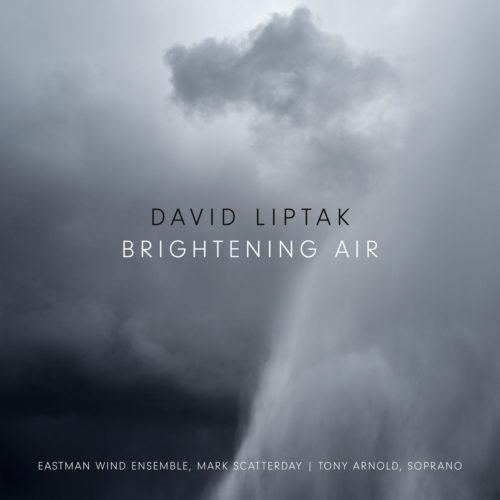https://newfocusrecordings.bandcamp.com/album/brightening-air
Brightening Air is also available on Spotify and Apple Music

https://newfocusrecordings.bandcamp.com/album/brightening-air
Brightening Air is also available on Spotify and Apple Music
David Liptak, longtime composition faculty member of the Eastman School of Music, releases this compilation of his music for wind ensemble, written for and inspired by the august group at his institution. Featuring soprano Tony Arnold in the four movement Folgore’s Months based on 14th century Italian sonnets, Liptak’s broad sources of inspiration and sensitivity to lyricism and orchestration pervade this release.
Brightening Air is composer David Liptak’s (Eastman School of Music) second release on New Focus, and stands in sharp contrast to the 2019 Dove Songs which featured intimate instrumentations. This recording celebrates Liptak’s large ensemble writing, specifically five works for wind ensemble performed by the celebrated Eastman Wind Ensemble. Throughout, we hear his brilliant orchestrational palette, complex management of layered characters, and compelling structural direction.
Soprano Tony Arnold is featured here in a powerful setting of 14th century Italian sonnets by Folgore da San Gimignano, in English translations by Daniel Gabriel Rosetti and John Thow. Liptak has chosen four months to present in Folgore’s Months: “February,” “August,” “May,” and “December.” “February” features powerful, towering chords in the brass and lively rhythms throughout the ensemble. Arnold enters with urgent, syncopated phrases that set a text that celebrates vigorous winter activity. “August” is languorous, with fluid lines in the soprano floating above a shifting harmonic foundation. Liptak creates a poignant polytonal texture as the winds obscure a diatonic brass chorale, capturing the ambiguity of late summer. “May” returns to the extroverted energy of “February,” here introduced by insistent repeated notes that crescendo in the brass, before opening up into expansive tintinnabulation under the text, “And every day be glad with joyful love.” The set closes with a shimmering setting of “December,” also shrouded in dualities. While the poetry describes “large fireplaces,” “fine carpets,” and “elegant game boards,” the undulating musical material is mysterious and foreboding, perhaps acknowledging the perils of the season ahead.
Soundings is the earliest work in the collection, originally written for the Michigan State University Wind Ensemble. In this colorful scoring, Liptak takes advantage of a hallmark of wind ensemble music, which is one to a part writing (as distinguished from concert band conventions), which creates a tapestry of soloistic features. Percussion plays a major role as well in this dramatic piece, lending support to crashing cadential moments with larger drums and adding brilliance to intricate passages with higher pitched percussion like crotales and glockenspiel.
The 2017 composition Through the Brightening Air is written in memory of composer Steven Stucky, a good friend of Liptak’s and an upstate New York colleague as a longtime faculty member at Cornell University. The first half of the work develops gradually, as swells and punctuations build accumulating sonorities before the tone takes a turn midway through, as a light hearted dance emerges. Dramatic brass chords lay the foundation for a haunting line in high winds before the work steadily distills its energy and closes with ethereal percussion.
Octet shares its instrumentation with Stravinsky’s 1922 Octet for Wind Instruments, and as such, puts itself in dialogue with the famous work, intentionally or not. The work opens with a short introduction, “It Began With a Dream,” an evocative layering of voices. Liptak seems to embrace the interaction with the canonic elephant in the room. The second movement, “Scherzo,” revels in rhythmically separated figures that dart and bounce in ways that are reminiscent of Stravinsky. “Fantasia” opens with gentle and lyrical material that grows into a coy imitative section of ascending lines. The “Finale” refers back to the staccato gestures of the scherzo, with extra boldness and urgency to lines that swell and emerge throughout the ensemble. The Octet is a wonderful opportunity to hear Liptak in a leaner context, exploring and extrapolating some focused compositional ideas with remarkable economy.
The final work on the recording, The Sacred Harp, was written in 1994 and returns to the rich landscape of the full wind ensemble. Written for the inauguration of an incoming president of the University of Rochester, Liptak draws inspiration from shape note singing, an American choral tradition which evolved in the eighteenth and nineteenth centuries. We hear a balance throughout the piece between simple folkloric material drawn from these sources and Liptak’s vibrant harmonies and orchestration.
– Dan Lippel
Producer: Mark Scatterday
Co-Producer: Kevin Holzman
Recording Engineer/Post Production/Mastering Engineer: John Truebger
All music was recorded at the Eastman School of Music in Rochester, NY